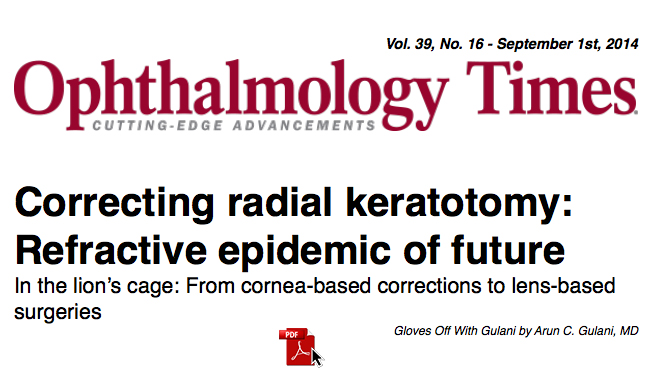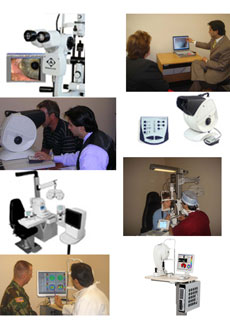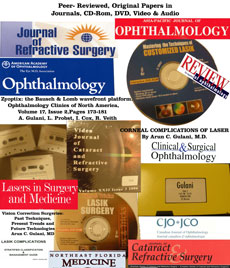
Radial Keratotomy
<

.jpg)
Radial Keratotomy (RK) is a procedure which involved radial cuts into the cornea (front clear window of the eye) so as to flatten the shape of this cornea and therewith correct nearsightedness (myopia).
This procedure was taught and propelled to the world by Dr. Svyatoslav Fyodorov from Russia who accidentally discovered this concept while treating a boy who had been involved in an accident that caused pieces of glass to make accidental cuts in his cornea and helped him see by correcting his nearsightedness.

The incisions of RK are used to relax the steep central cornea in patients with myopia. Popularized by Dr. Svyatoslav Fyodorov of Russia, the original technique of incisions from periphery to center was called the Russian technique (Gulani AC, Fyodorov S: Future Directions in Vision course, June 1997) while the later advances of performing controlled incision from center to periphery was called the American Technique (Gulani AC, Neumann AC: Refractive Surgery Course, Feb 1996).
In radial keratotomy (RK), incisions are made with a precision cailberated diamond knife. Radial keratotomy enjoyed popularity during the 1980s and was one of the most studied refractive surgical procedures. Its 10 year data was published as the PERK (Prospective Evaluation of Radial Keratotomy) study, which proved the onset of progressive hyperopia (farsightedness) often found a decade after the original surgery is due to continued flattening of the central cornea over time.

A conceptually opposite technique of using hexagonal incisions in the periphery of the cornea is known has Hexagonal Keratotomy or HK (described by Dr. Antonio Mendez of Mexicali, Mexico), which was used to correct low degrees of Hyperopia. The idea of HK was to make six peripheral incisions to form a hexagon around the central cornea to steepen the hyperopic (farsighted) flat cornea and thereby focus the rays of light onto the retina. These incisions could further be of two types: connecting and non-connecting (Gulani AC: 10 Refractive Procedures for Hyperopia. ISOPT  2001).
2001).
Patients with Radial Keratotomy (RK) may present with a variety of incisions. They can have 4,8,16 or 32 incision surgeries and also all kinds of patterns and linearity based on their refractive errors, surgeon's style or training when it was initially done. Many of these patients have had additional incisional surgeries like Astigmatic Keratotomy or AK where incisions are placed at the steepest points of the cornea in patients with astigmatism to relax and transform the cornea to a more spherical shape. Some patients have had a combination of intraocular surgeries such as Pseudophakia (cataract surgery)or Phakic implants along with their keratotomies and many of them also underwent purse-string suture to control the over-correction .
Technological challenges of how to calculate the IOL power post RK surgery for an associated cataract as well as the aberrations induced along with surgical complexity make RK patients fly from all over the world to Dr.Gulani for his focused care in such cases.
The presenting visual complaints can range from hyperopia (farsightedness) as stated by the PERK study and that too at an age of Presbyopia (after 40 reading glasses). Both these conditions require Plus lenses to correct them and therefore are a compounded problem.
RK patients can also present with  associated age-related cataracts.
associated age-related cataracts.
Dr. Gulani can diagnose all refractive errors with RK that are affecting vision during a thorough eye exam using sophisticated diagnostic technologies like Pentacam, OPD analyzer, Automated Refractor and Ophtec vision systems.
Thus using his skills as an ART , Dr. Gulani picks exactly what technique and technology he would like for each patient even if it involves combination surgery (ie. Advanced Lasik or Laser ASA, Cataract with Lasik, ICL with Lasik etc) to address all refractive errors and "TURN BACK THE CLOCK" for patients so they can once again enjoy the vision freedom they are so eagerly looking for.
Click Here to Schedule Your Radial Keratotomy Consultation

 About Dr. Gulani
About Dr. Gulani
Dr. Gulani is a world renowned eye surgeon and Radial Keratonomy specialist. Former Chief of the Cornea service and Asst. Professor at University of Florida, School of Medicine; he is Founding Director of the Gulani Vision Institute.
Browse Our Site







